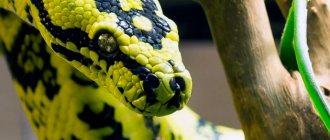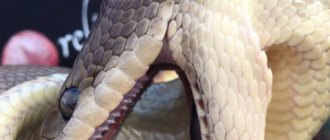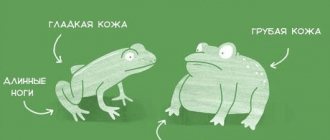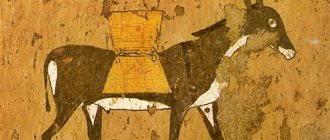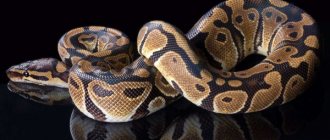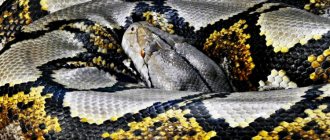Captivity[edit | edit code]
general information
Today, the royal python is one of the most popular snakes for lovers of exotic pets.
Under natural conditions, this species of snake lives in western Africa. Its favorite habitat is savannas and open forests near water, in which snakes escape the heat, but they still spend most of their time in burrows. The royal python is active in the evening and at night, which is when it hunts birds, lizards, and small mammals. In captivity, with good care, royal pythons feel very comfortable, they are not picky. They can bite, but this is rather a rarity than a common occurrence, since this form of protection is resorted to only in emergency cases, usually they curl up into a tight ball - a ball, for which the royal python is also called the “ball python”.
Life expectancy: in the wild - 10 years, at home they live up to 30-40 years.
Puberty is at the age of 3-5 years.
Advantages
one of the smallest pythons in size;
- has a beautiful color;
- unpretentious in content;
- non-aggressive, peaceful.
Description
The royal python has a muscular body, its diameter is from 10 to 15 cm, there is a rather large triangle-shaped spot on the head, there are lateral oculotemporal stripes, with a yellow stripe between them. The color is dominated by black, beige and yellow, the stripes can be varied and run on the sides. Thanks to its bright, unusual coloring, this type of python got its name - royal.
Like many snakes, the royal python has a long, branched tongue. Females differ from males in size; they are slightly longer - from 1.2 to 1.8 m, and males - 1 m. Pythons grow quickly, in the first three years of life they increase 30 cm annually.
Content
Royal python in a terrarium The royal python is one of those that is quite easy to keep; caring for it will not be difficult for you. They need a spacious glass or plastic terrarium; at a young age (until they grow to 90 cm) they can be kept in a 35-liter terrarium, and then, when they grow up, it is worth increasing their place of residence. The perimeter of their “apartment” must be at least twice the length of the residents, so that there is room to turn around.
A mandatory condition for keeping this snake at home is the presence of a lid on the terrarium; you don’t want your pet to go for a walk around the room. In addition, the lid must have holes to provide ventilation. For bedding, you can use paper towels, newspaper, artificial substrate, but sawdust is definitely not suitable for this purpose.
Since in nature the royal python likes to hide, but in captivity you need to create such secluded places for it. The optimal temperature for a python’s life is 25-29 °C during the day, and at night – 20-23 °C. Heating mats can be used for heating. To bathe your pet, you need to make a small pond in his home; make sure that the water in it is always clean.
Feeding
A special point in caring for royal pythons is nutrition. They can be fed frozen mice, rats, chickens, hamsters, live animals can be fed provided they are first stunned to avoid injury. The frequency of feeding depends on the age and size of the python. For young people - once every five days; for adults, once every 10 days is enough. And don’t forget about vitamin supplements to ensure your pet gets all the nutrients it needs to stay healthy.
Safety
Royal pythons
so calm that even small children can easily and safely keep them as pets.
- Morphs of royal pythons
- Royal python of natural color (“normal”)
- Albino royal python (“albino”)
- The variegated coloration of the royal python includes a pure white color of the skin surface (Pied ball morph).
- "Platinum morphism" of the royal python
- Hypomelanistic royal python (orange ghost morph)
- Royal python, spider morph
- Royal python, woma morph
Natural enemies of dog-headed boas
Photo: Dog-headed boa constrictor in nature
The dog-headed boa constrictor is not overly large in size, like its other constrictor constrictors, or poisonous, but its teeth are very impressive, and the muscles of the body are extremely strong, so it can bite its opponent seriously, and it is not possible to get out of the suffocating embrace of the reptile. Living under a canopy of branches and green foliage helps the boa constrictor to remain unnoticed, because its beautiful color is, first of all, an excellent camouflage, helping both when hunting and to hide from the enemy.
Despite all the protective functions of the arboreal reptile listed above, it has plenty of enemies in natural conditions. A variety of animals can defeat a mature dog-headed boa constrictor.
Among them are:
- jaguars;
- large feathered predators;
- wild boars;
- caymans;
- crocodiles.
Newly born snakes have the most ill-wishers, because their mother leaves them immediately after they are born. Slightly older young animals are also very vulnerable, because does not have the proper experience and has not reached the required size. Young snakes often become victims of coyotes, kites, monitor lizards, jackals, hedgehogs, mongooses, and ravens. So, it is not easy for dog-headed boas to survive in harsh natural conditions, especially for those who are still very small and have not gained life experience as a snake.
Lifespan
The common boa constrictor grows throughout its entire life. In the natural environment, the age of these snakes can reach 25-27 years. Specimens that live in artificial conditions can live up to 40 years. This is possible if the terrarium for the common boa constrictor has the required dimensions and the necessary temperature conditions are maintained in it.
The boa constrictor can often be seen in various films, where it appears as a terrible predatory monster that attacks people. But in reality this is not at all the case. History knows only isolated cases of attacks by this reptile on people. For the most part, they do not pose a significant threat to humans.
The longest python Medusa living in captivity
Did you know that the longest snake on Earth lives in captivity - her name is Medusa. The length of this giant, listed in the Guinness Book of Records, is 7.67 meters, and its weight has exceeded 158 kilograms. It takes at least fifteen people to hold this formidable handsome guy in his hands, and he doesn’t always like it when people touch him. It needs more than 14 kilograms of animals per week, although the python can eat more rabbits, piglets, deer and rodents.
Several times the snake easily “dined” on the carcass of an animal whose weight was over 40 kilograms. The owner of Medusa himself claims that the snake is dangerous for an adult, and his pet can easily kill him if he is dissatisfied with something. But fear is a bad advisor when dealing with such large reptiles.
Python attack on a person
There are many cases in history when pythons attacked people and mercilessly swallowed them. One of these terrible cases occurred in 2022, in Indonesia. According to BBC News, one day a 54-year-old woman disappeared in the province of Sulawesi. Local residents organized a search and a few days later they found sandals and a machete, next to which lay a huge python with a swollen belly. People suspected that the snake could swallow the woman and cut the animal's body. To everyone's horror, the nearly intact body of the missing woman was found inside. Photos from the scene of these terrible events could be found on Indonesian social networks, but we will not publish them.
Boas and pythons in Africa
There are giant snakes in the African jungle. But there are cobras that spit venom into the eye and blind a person if they fail to bite. Africans hunt pythons of any size, and when killed, several people carry the body of the snake to the village. The Aboriginal weapons are spears.
Boas in Africa grow up to 6 - 7 meters in length. The python has 118 pairs of ribs, and it moves on them, and quickly. It strangles the victim with its ribs.
The African python almost never attacks people. It happened that a boa constrictor ate children, swallowing the human body whole. Once he swallowed a soldier in uniform. In 2002, a snake attacked a 10-year-old child, eating the boy.
The python does not have poisonous glands; its smallest species is only one and a half meters long. Boas hunt at night, attacking small rodents.
Many zoos around the world keep Royal pythons, but there are people who decide to keep similar boas at home. The snake loves warmth, and if you feed it, this reptile is usually quite peaceful. Of course, to keep a python you need a terrarium, and not to give it an apartment at its full disposal.
Africans talk about pythons over 10 meters long! Such a snake can swallow an antelope whole. The boa constrictor hunts from an ambush, quickly overtaking the victim, breaking its ribs and swallowing it. Straightening up like a spring, the python can jump a considerable distance. It can also float on water.
Origin of snakes
Scientists do not know exactly when pythons and boas appeared on our planet. But recently, the fossilized remains of a python, 47 million years old, were discovered in the Messel quarry (Germany). A new to science, but already extinct, species of python was named Messelopython freyi. The length of the ancient snake was only a few tens of centimeters, which suggests that it fed on small animals. How exactly the snake hunted them is still unknown to scientists. Perhaps, like the huge descendants, the discovered creature strangled its victims. After all, pythons and boas are the only snakes that infect their victims even without poison.
The same fossil python
Portholes and teeth
The most obvious and noticeable difference between a boa constrictor and a python is the structure of the skull. The python does not have an eye bone, and its Latin American relative does not have one.
Of course, not everyone who is looking for an answer to the question of how a glutton differs from a python will dare to look into the mouth of a living snake. But one of the differences lies here. If you discover that the snake you are examining is toothless, you can glibly declare that it is a boa constrictor. All pythons have teeth on the premaxillary bones, with which they can reach for flesh. Among the family of pseudopods there are many species that lack teeth at the root, but there are also toothed ones.
Note that neither pythons nor boa constrictors can crack. Their teeth are just hooks through which they are held on the carcass of a caught animal. Representatives of both families do not grind food before swallowing, as humans do. Snakes simply open their heads wider and put them on the unfortunate victim.
There are no poisonous glands in boas, nor in pythons, and that’s all. Accordingly, poisonous teeth, equipped with tubules for introducing secretions into the pupus, are also absent.
Python - description and characteristics. What does a python look like?
Pythons are known as very large snakes, reaching up to 10 meters. According to some scientists, the reticulated python (lat. Malayopython reticulatus) is the longest snake in the world. The weight of large individuals can exceed 100 kg. According to the Guinness Book of Records, the largest and heaviest python living in captivity is the dark tiger python (Python bivittatus) called Baby. Its weight is 182.8 kg. The longest python listed in the Guinness Book of Records is the reticulated python Samantha (lat. Python reticulatus) measuring 7.9 meters.
The smallest representative of the python family is the small spotted python (lat. Antaresia perthensis, syn. Bothrochilus perthensis), which lives in Australia, which grows to only 30-50 cm in length. An adult reptile weighs only 200 grams. Newborn snakes of this species reach a length of 17 cm and weigh 4 g.
Representatives of the family do not have massive bones, so the body of reptiles consists mainly of muscles. Their strength is such that large pythons easily break bones, for example, a crocodile or a leopard.
The snake's body is slightly compressed from the sides, while the python's head is clearly separated. Pythons have vertical pupils.
The premaxillary bones have teeth. The palatine bone in some species is toothless (for example, in black-headed pythons), in others it has teeth, the number of which reaches hundreds. Pythons' teeth are directed backwards; there are 4 rows of teeth on the upper jaw and 2 rows on the lower jaw. Representatives of the family do not have poisonous glands.
Pythons have a good sense of smell. On the upper and lower labial scutes of many species there are 2-4 pits located in front of the muzzle. These are some kind of thermolocators. With their help, pythons detect infrared radiation from warm-blooded animals and can hunt using only these organs.
Black-headed pythons do not have thermolocators.
Representatives of the family have developed both lungs, which are unequal in size. On both sides of the anus of reptiles there are small keratinized claws, slightly protruding above the scales - these are the rudiments of the pelvic bones, called false legs. In males they are more developed than in females. Their size can be used to determine the sex of the snake.
The coloration of the representatives of the family is very beautiful and varied. There are species that are more or less uniformly colored, for example, the olive python. But, basically, the skin of pythons is decorated with stripes, spots, speckles or fancy patterns. The names of the species indicate this: carpet, hieroglyphic, tiger, mesh. There are a variety of colors in the color: red, green, white, yellow, fawn, black, brown, cream, olive, orange and others. There is skin with iridescent tints, such as that of a reticulated python.
Among pythons, there are albinos with light or white skin, red eyes and a pink tongue. It is difficult for such reptiles to survive in nature: they have no camouflage, they can be seen from afar, and they easily become prey for predators.
Albinos are often found in zoos and terrariums.
In captivity, thanks to long-term selection work, numerous morphological changes in the colors of the skin of pythons were obtained, which was a consequence of genetic mutations. For example, the royal python has a huge number of morphs.
The colors of captive-bred snakes include white, yellow, gray, brown, black, reddish, and the spots have different shapes. Some morphs have no spots at all: instead, there are stripes on the python’s skin.
Royal Python morphs: 1. Reduced Pattern Banana Clown; 2. Spider Clown; 3. White Wedding; 4. Banana. Taken from: www.morphmarket.com
External parameters and their differences from other types of snakes
We can talk for a long time about the appearance of these animals. The variety of patterns and colors of these animals simply amazes the human imagination. There are snakes with completely different patterns on the skin.
There is something unearthly or alien in the appearance of the Green Python. In other words, his name is also Woody
. It is distinguished by its unusually attractive bright color. Its body reaches approximately 1.5 to 2 meters in length. The green python is the most striking representative of its genus, but it does not have a complex pattern on its skin.
Dark tiger python
can reach a length of up to 5 meters. Larger individuals can also be found. But most often they do not grow more than 3.7 meters. This giant can be found in Indonesia and southeast Asia. The skin of this snake is a very expensive material.
Royal pitot
The body length can reach a little more than 1 meter. This species is African. They are nocturnal. If you don’t know all the features, you can easily confuse the Reticulated and Tiger pythons. Almost always females are larger than males. This difference in body length can be up to 25%.
Structure
Few people know, but some snakes, in the process of evolution, for some reason retained the rudiments of the bones of the lower limb girdle. Boas and pythons are examples of this. But the similarities end there; the structure of the rudiments differs.
Male pythons have preserved rudiments of the pelvic bones and hook-like tiny legs, located on the sides of the anus. Of course, the limbs are not functional; they are not even used when climbing trees. Again, one feature that distinguishes a python from a boa constrictor is the preserved rudimentary mortal remains in the hemipenes. With these shoots, the male rubs the female during the ancient years of mating games.
The boa constrictor also has small rudimentary processes with remains of bones, located almost at the anus. They look less like claws, like those of a python, but like dried paws. Attached to the rudiments of the pelvic bones. In contrast to the python, this trait is found in boas of both sexes.
What you need to know
Pythons and boas are two different species. They are similar in appearance, principles of behavior and other characteristics, so it is quite difficult for the common man to distinguish them. The main differences are in living conditions and method of reproduction.
The first (about 30 species) live in Africa, Australia, tropical Asia and some islands (Guinea, Philippines), only one species lives in Mexico. Boas (about 60 species) live in the tropics and subtropics of America, as well as in the Bahamas and Antilles, Madagascar, and small species also live in Asia and even Europe.
All boas are viviparous, while pythons lay eggs, the latter warming the clutch with their own body (through periodic muscle contractions). These animals are so closely related that some biologists propose combining them into one species.
Bite – is a means of defense or attack
In the first case, this can happen due to careless or aggressive behavior with the snake, but more often they bite animals that are smaller than them in order to capture and further suffocate
Attacks by even large individuals on humans are rare. The most common types are listed in the table; their behavioral characteristics are described in the video posted in this article.
Table. Common types of pythons:
Name Features Distribution Level of aggression
brindle
Length from 1.5 to 4 m or more. The color is variable (from brown to olive) with large spots forming a characteristic pattern. Distributed in South and Southeast Asia (forests, shrubs and swamps) The character is calm, so these snakes are popular among reptile lovers.
Reticulate
The size is more than 10 m. The color is bright, the eyes are expressively yellow. It feeds on small and medium-sized ungulates and monkeys. Philippine and Moluccas Islands Bites more often, which is why it is not often kept in captivity.
Hieroglyphic or rock
The average length is 5 m, but there are individuals up to 7 m. Food is small rodents, ungulates and even small felines, for example, leopard. Distributed in Africa, in rocky areas, savannas, among bushes and woody vegetation. Sometimes they attack small people, there are deaths (small people up to 50 kg). In captivity it is timid and reproduces poorly.
Amethyst
The average size is about 5 m, but individuals over seven meters are not uncommon
Feeds on bush kangaroos. Australia The character is aggressive, has long and sharp teeth and, if handled carelessly, often bites, which creates certain difficulties when kept in captivity.
Features and habitat of the python
Pythons have long won the title of the largest reptiles on the planet. True, the anaconda competes with them, but after a 12-meter-long reticulated python was discovered in one of the zoos, the anaconda’s primacy is already in doubt. Many people believe that the largest snake is the python . And yet, the main size of these snakes is from 1 meter to 7.5.
The coloring of these reptiles is too diverse. There are species with skin of brownish, brown tones, and there are also those that are simply amazing with their brightness and variegation. As a rule, these are all kinds of variations of spots. Scientists say it is impossible to find two pythons with the same spots. Pythons can also be of the same color (green python).
At first glance, all snakes look alike, but differ only in size and how they get their food - whether they strangle the victim or kill with poison. However, this is a misconception.
The python, just like the boa constrictor, does not release poison into the body of the victim; the python is not a poisonous snake and prefers to suffocate future food. However, pythons and boas are two completely different species, and there are significant differences between them.
The python has two lungs, and humans have two lungs. But other snakes, including the boa constrictor, make do with only one, which is too elongated. Unlike boas, the python also has teeth.
This is easy to explain - the boa constrictor crushes its prey with the force of its muscles, it is not afraid that the victim will have to escape. The python also strangles its prey, but very often it also has to hold its prey with its teeth.
Once upon a time, these snakes apparently knew how to run, because they still have vestiges of limbs. Now these are only small claws (anal spurs). There is one more feature that distinguishes a python from a boa constrictor.
In the photo are the rudiments of the hind limbs of a python
An interesting fact is that the hemipenes of these snakes contain vestigial bones. Due to the presence of these bones, the python snake cannot pull this organ inward, but they can use such a bone during the mating season - they rub the female with it.
And there is also a feature of pythons that no reptile can boast of - they can control their body temperature. They cannot maintain the desired temperature for too long, and they cannot keep it in one state either, but when they get cold, they increase their body temperature by 5-15 degrees, which is very noticeable and helps them in difficult situations.
And he does this simply - he contracts the muscles of the whole body, which leads to warming. The climates of Africa, Asia, and Australia are most suitable for these reptiles to live in the wild. Once upon a time, they were taken as pets to the USA, Europe and South America.
The python has teeth, unlike the boa constrictor
But an interesting fact is that in Florida these reptiles managed to escape into the wild and they survived. Moreover, the conditions in Florida also suited them, and they began to reproduce successfully.
They even began to sound the alarm about this, allegedly because too many of these snakes were disrupting the ecosystem. But scientists do not agree; nevertheless, the number of these reptiles there is not so terrible.
Character and lifestyle of a python
Often, if you look at a photo, the python is displayed there, curled up in a ball. This position, as it turns out, greatly slows down the process of cooling the body and increases the snake’s chances of sensing and recognizing prey.
Snakes, even very large ones, are excellent swimmers, and they love water. But the largest pythons are tiger, hieroglyphic, reticulated, they prefer to be more on the ground.
Here they search for and catch their prey, rest here, and sometimes climb trees, but not too high. And there are also species that do not descend to the ground at all, and spend their entire lives in trees (green python). They feel free on any branch, with the help of their tail they deftly move up and down, and rest, catching their tail on a branch.
If the python is large, then not many people dare to attack it; it has too few enemies. But small snakes have a number of “ill-wishers”. Crocodiles, lizards, and even birds (storks and eagles) are not averse to tasting snake meat. Cats and other predatory mammals do not refuse such prey.
What do boa constrictors eat?
The diet of reptiles is quite varied. It consists of both small animals, birds and amphibians, and quite large animals such as antelopes and crocodiles. Small boas typically hunt for:
- Opossums.
- Mongoose.
- Frogs.
- Lizards.
Their diet often includes a variety of waterfowl and ordinary birds such as ducks and sparrows. In addition, agoutis are typical prey for boas.
Cuban boas include bats in their diet.
Large boas like anacondas are capable of attacking turtles, caimans and capybaras. Snakes can also attack pets that come close to water, such as dogs, pigs or chickens.
Characteristic
Python is
large non-venomous snake. This is a very dangerous predator. Its body can reach sizes of 7.5 meters. The largest representative is the reticulated python.
These reptiles are inactive. They prefer warm climatic conditions and temperatures not lower than 25 degrees. These snakes are capable of climbing trees and swimming. It is for this reason that the list of their prey is very long.
The python is related to the boa constrictor
. But it differs from it in both external and internal features. Zoologists count 9 genera of these reptiles, and each of them has several varieties. In total, scientists studied 41 species of this dangerous, large and beautiful snake.
The classification by gender looks like this:
There is also information that a couple of species have already become extinct. The Australian dwarf species is best suited for captivity or terrarium keeping. And all because of their size: weight is approximately 200 grams, and body length is 50 centimeters.
There are serious reasons to consider the python a dangerous snake, but they have no poison.
Anaconda from South America
In the same Hollywood, films were also released about a gigantic anaconda attacking people from under the water of a river. But this snake lives in the jungles of South America, and is shorter than the reticulated python. An anaconda once swallowed a 42 kg puma in Brazil. Boa constrictors have the same attack methods.
Video "Anaconda vs. crocodile"
Green python in New Guinea
In the forests of New Guinea there lives a green python, very beautiful. The emerald-colored scales of the boa constrictor are sometimes spotted with white spots. The length of the kite is no more than 1.5 meters. It usually hangs on the branches, curled into rings. Hunts lizards and frogs, does not disdain small rodents. When attacking a victim, it strangles and then swallows.
New Guinea pythons are not all green; there are some with blue scales, skin, and orange and yellow ones. When several colorful boa constrictors hang on tree branches at once, it resembles a reptile masquerade.
Main features
No matter how strange it may sound, the python has legs. Of course, not the same as in humans or animals, but rudimentary hind limbs. All that remains of full-fledged limbs today looks like small claws. In science they are called anal spurs. And this is due to their location.
In addition to paws, each species of this snake has rudiments of the pelvic girdle. These animals have two lungs, just like every human and mammal. Other snakes (black mamba or viper) have only one lung - the right one, which is extended along the body.
The python also has teeth that are located on the submandibular bone. These reptiles also have supraorbital bones. All mothfish, lizards or snakes have a specific sexual organ called the hemipenis. In this species of reptile, it has rudimentary bones that completely prevent the genital organ from retracting. During the mating season, male reptiles rub such bones against females.
Who's eating?
It feeds mainly on live frogs, rodents and, less commonly, fish. The enemies of snakes are storks, birds of prey and some mammals.
Interesting materials:
What can you make from small cardboard boxes? What can you make from small leftover yarn? What can be made from lemon balm? What can you make from small scraps of fabric? What can be done from unnecessary photos? What can you make from Unrisen Dough? What can you make from tulle scraps? What can you make from an ordinary box? What can be made from a fire rod? What can be made from the remains of diamond painting?
What to do if bitten by a python
Teeth on a python's jaw
The severity of the pain and the damage caused will directly depend on the size of the animal. When a python has grabbed the skin (as shown in the video in this article), then attempts to open its jaws with your fingers are often not only useless, but also pointless, because in this case the phalanges will be scratched by the snake’s teeth.
In order to remove the aggressor from your hand, you need to inject alcohol or vodka into his mouth. Ethanol will not cause any harm, but the strong smell and burning sensation will cause the snake to unclench its jaws.
Symptoms after a bite:
- teeth marks on the skin;
- bleeding of wounds, it can be intense with a strong bite, for example, if the python made a jerk;
- slight swelling and redness around the wounds;
- itching and irritation are rare, but not excluded.
If an attack does happen in the wild, then the wound should be washed with soap and clean water and wrapped with any clean cloth that is at hand to stop the bleeding and prevent the entry of pathogenic bacteria.
At home, first aid instructions will be as follows:
- wash the wound with soap;
- rinse the bitten area well under running water;
- dry with a clean napkin or cloth and treat with an antiseptic (hydrogen peroxide, 70% alcohol, brilliant green or others);
- in case of pain or severe bleeding, cold will help; ice can be applied for no more than 10–15 minutes;
- After stopping the bleeding, dry the bite site, treat the skin around the wound with iodine and apply a bactericidal patch or bandage.
Usually the wounds heal within a week or two and no marks are left on the skin. The most likely complication may be the development of an inflammatory process in the event of the introduction of pathogenic microflora.
In this case, the following clinical picture develops:
- the skin next to the wound becomes hot and red;
- a putrefactive process is indicated by swelling and the formation of a white mass visible under the skin and an unpleasant odor;
- with a strong process, temperature is likely;
- If you do not stop the intoxication, then signs of dyspepsia and nausea are likely.
Such symptoms are a good reason to go to the clinic. The doctor will examine the wounds, order tests and prescribe the recommended treatment. If everything is done on time, the cost of therapy will be minimal, as will its duration.
Comparison of pythons and boas
What is the difference between pythons and boas? Pythons prefer tropical and equatorial forests. They happily settle near water and are excellent at climbing trees. They prefer to hunt and move in the dark. Boas prefer the same humid, warm forests and love water treatments. They also choose the night for hunting and fulfilling basic physiological needs. Both families have dimples on their faces - thermolocators, allowing them to easily find prey. Externally, pythons and boas are very similar. The size of pythons varies from 60 cm to 10 m, but boas also grow up to 10 m. The coloring of both families of animals depends on the environment in which they live. The bright green and spotted ones are the ones that live in trees. Brown and brown-brown animals are those that spend most of their time on the ground. Pythons and boas can be visually distinguished by examining the head. Pythons have a prominent supraorbital bone. In boas, the eyes are not protected by either a prominent bone or scutes. Pythons have teeth on their premaxillary bones, which they use to hold prey. Among boas there are toothless and toothed species. The teeth grow on the intermaxillary bones. In both families, the jaw bones are connected by elastic ligaments. Both families of animals are characterized by the presence of rudimentary girdles of the hind limbs and pelvic bones. They are noticeable in males, in whom they are presented in the form of small claw-shaped outgrowths on the sides of the anus. Both families of reptiles have a pair of lungs. But there is some difference in the structure of the copulatory organs. Male pythons have a rudimentary bone in their hemipenes. Therefore, in pythons, a “non-retractable” penis is visible between the underdeveloped remains of the hind limbs, which distinguishes them from boas. Another significant difference between the two groups of animals is reproduction. All pythons are oviparous animals. Female pythons independently “hatch” the laid eggs. At the same time, the muscles of their body contract, heating the air in the middle of the ring with such work 15°C higher than the temperature of the atmosphere
This is especially important at night, when even in the tropics the temperature drops below +24°C. The incubation process lasts about two months
But most boas are ovoviviparous. Only certain species have a preference for laying eggs.
Characteristics of boa constrictors
Unlike poisonous snakes, boas use a different method of hunting - they do not bite their prey, but strangle it. Pythons and anacondas do the same. The variety of boas is much greater. To date, 60 species are known to exist.
Interesting: What is the difference between a romance and a song?
Characteristic features of boas are a muscular body and a flattened head. It is worth noting that even for a specialist it is difficult to determine at first whether it is a boa constrictor or a python, they are so similar. But boas are more “slender”, and among their many species there are also small individuals. And among the pythons there are more giants.
Another major difference is the method of reproduction. Boas lay eggs, but the young hatch almost immediately (ovoviviparity). Pythons guard the masonry for a long time and warm it. For example, a female tiger python does not leave eggs for two months.
The scales of the boa constrictor have a spotted or striped pattern. The color range is varied: from faded to bright shades. Those species that spend most of their time in the ground are distinguished by one specific color.
Dog-headed boa
You can meet boas in Central, South Asia, North Africa, Madagascar, the Malay Archipelago, Central, South and some regions of North America, Transcaucasia. Even in Europe there is a variety of small boa constrictors that live on the Balkan Peninsula. Thus, their distribution area is much wider.
Interesting fact: the closest relative of the boa constrictor in structure was the extinct Titanoboa snake. Its length, judging by the analysis of the skeleton, was about 13 m, and its weight was more than a ton.
Boas prefer coastal areas, steppes, forests and deserts. There are even “highly specialized” reptiles. For example, Madagascar and dog-headed boas are arboreal species. They cannot be found on the ground, since these snakes never come down from the trees.
There are species that live in the ground and lead a burrowing lifestyle. For example, the Cuban ground boa. Such snakes move shallowly in the soil or hide among stones.
Interesting: What is the difference between a proverb and a saying?
Pythons and boas differ in the presence of teeth, some structural features, and method of reproduction. It is quite difficult to distinguish them externally. A sure sign of a python is the supraorbital bone, which protects the organs of vision.
If you find an error, please select a piece of text and press Ctrl+Enter.
Nutrition
Python is a born hunter
, which attacks its prey with full confidence that it can handle it. When hunting, the python does not bite the victim, but squeezes it in a suffocating fight. The entire snake body at such moments resembles a self-tightening knot or constrictor.
The python, whose body length reaches 5 meters, can easily swallow a small predatory cat or an entire jackal. Perhaps this is due to the structure of the jaws.
The python eats only 5 times a year
. Large prey can take weeks or even months to digest.
Snakes of this species prefer large lizards or birds. Smaller species or young animals eat small reptiles or rodents.
The python's teeth help it capture its prey during the hunt. And after that, the python finishes off its victim with the rings of its own body.
In captivity, people mostly keep tiger pythons. The reason that they choose him is his calm nature and adaptation to life in the conditions of a human home. Very often, the weight of a python can exceed the weight of its owner.
A baby python is capable of
swallow a one-day-old chick or mouse. Older individuals are given a rat as food, and then a rabbit.
A tiger python whose body length exceeds 3 meters must eat an adult whole chicken in one meal.
It is very important that the food given to the reptile is warm-blooded and alive. Only in this way can we provide nutrition similar to natural conditions
In their natural habitat, pythons hunt with the help of special organs with which they perceive the heat of the prey.
Some scientists believe that reptiles kept at home should not be given live food.
. They attribute this to the fact that prey can cause damage to the hunter in the struggle for life.
But this is all wrong. The snake is ready for such dangers. The python must have 24/7 access to fresh, clean water.
The males of these reptiles
smaller in size than females. Mating occurs by friction between the male and the female. In this case, the male scratches the female with his anal spurs - vestigial hind limbs.
It is worth noting that when it comes to the reproductive process, this family of snakes is truly oviparous. In other words, the female, having laid her eggs, incubates them to the end.
In this case, the temperature in the masonry exceeds the ambient temperature by 15 degrees. 41 species of these snakes lay the largest number of eggs among all reptiles.
After mating
After about three months, the female brings eggs. There are approximately 60 of them, but in rare cases this number can be larger.
The female python curls up into a dome-shaped figure over a clutch of eggs. As a nest, pythons usually choose trees that have voids inside the trunk.
Only the female takes care of the future generation. Reproduction in all types of pythons occurs in autumn or winter. But boas, which are very close relatives of pythons, are not oviparous
. The cubs develop in the same way as pythons, but they hatch in the mother’s body and only then are born. It is for this reason that the ability to lay and hatch eggs is a very interesting feature of these snakes.
Many people use the terms “python” and “boa constrictor” as synonymous words. After all, they understand that both terms characterize large, powerful, non-venomous snakes that kill their victims by suffocating them in the coils of their coiled body.
Python nutrition
Pythons are carnivores and prefer to eat exclusively meat. They first lie in ambush and wait for the victim for a long time. When the victim approaches the permissible distance, a sharp throw follows, the victim is knocked off his feet, and then the python wraps itself around the prey, strangles it and eats it whole.
The larger the snake, the more prey it needs. Not too large snakes catch rodents, rabbits, chickens, parrots, and ducks. And large reptiles attack kangaroos, monkeys, young wild boars and even deer. There is evidence of a python eating a crocodile.
The black-headed python is considered a special “gourmet” among these snakes. His menu includes only monitor lizards and snakes. During the fight, the poisonous prey sometimes bites the hunter, but the snake venom does not affect this python.
It is believed that this reptile cannot swallow prey that weighs more than 40 kg, so an adult cannot become food for the snake. In addition, the human figure is not a very convenient object for swallowing.
The python does this with animals - it begins to swallow its victim from the head, the snake’s mouth stretches to incredible sizes, and then gradually the snake’s body begins to stretch over the carcass, like a bag.
Moreover, at this time the snake is too vulnerable. It is extremely inconvenient to do this with a person - first the head passes through, and then the shoulders move forward, and they prevent the body from easily moving into the snake’s stomach. And yet, cases of attacks on humans have been recorded.
Having eaten, the python goes to rest. It will take him more than one day to digest food. Sometimes such digestion takes several weeks, or even months. During this time, the python does not eat. There is a known case where a snake did not eat for 1.5 years.
Python bites
The size of a python's teeth depends on the size of the snake.
Both in the wild and when kept in captivity, animals rarely attack humans.
In the first case, this can happen for two reasons:
- a hungry animal sees a person as a potential victim (children, small people, women);
- for protection purposes.
Over the past 100 years, only a few cases of attacks on humans have been recorded. There are fatal cases when large snakes hunted representatives of small peoples of Africa and other tropical countries, but children suffered more often.
Pythons have teeth turned back, which is necessary for holding and capturing prey. Their number and size will depend on the type and size of the snake. For example, a reticulated python 5 meters long has teeth of approximately 10-14 mm.
Thus, after an attack, numerous marks remain on the skin, usually from 8 to 40 punctures. The amount of blood and the severity of the pain will depend on the force of squeezing the jaws and the mood of the snake - the more it wriggles and pulls the skin, the deeper the wounds will be, therefore, there will be more blood.
Hungry animals are the most aggressive
When kept in captivity, the manifestation of aggression is often associated not so much with the disposition of the animal, but with the fact that it is hungry. If fed incorrectly, snakes become more aggressive and may attack. This often happens if the next feeding was missed and when opening the terrarium (in order to place food in it), you may encounter unexpected behavior from the python.
The bite itself does not pose a mortal danger, because pythons do not have poisonous glands or any toxic substances in their saliva. The danger may come from infections and pathogenic bacteria, which will cause inflammation.
Allergic manifestations are also quite rare, but are possible if a person has an increased individual susceptibility to the components of saliva.
In the latter case, the following symptoms will appear:
- increased hyperemia;
- edema;
- increased temperature both locally and throughout the body;
- dizziness;
- nausea.
The development of an allergic reaction to anaphylactic shock is theoretically possible, but unlikely.
- What is first aid for a viper bite?
- Rattlesnake bite: first aid
- A snake bite can be dangerous, but was it really a snake bite?
Diet for a snake
They are predators by nature. They have their own special hunting style. The diet includes food of animal origin: reptiles, birds, small mammals. Some snakes inject paralyzing venom into the victim's bloodstream when they bite.
The poisonous snake boa constrictor never existed. He acts differently. The boa constrictor pinches the arteries, destroying the circulatory system of the prey. It strangles the victim with its body rolled into tight rings. Some species secure prey with strong fangs.
The habitat of these non-venomous snakes
These reptiles settled in the eastern hemisphere of the planet, including Australia, Asia and Africa
. They cannot be found in America. These large snakes on the African continent live mainly south of the Sahara Desert.
Representatives of different genera of this species live in different areas. Because of this, you can see snakes that are completely different from each other.
First of all, it differs
color and pattern of the skin of this reptile. Most of these reptiles live where there are bushes and trees. In desert areas, pythons are much less common. Near bodies of water, these reptiles can be seen very often.
This species of reptile has adapted to life in various landscape and climatic conditions. In tropical areas, these snakes can be found most often. But they are sometimes found in savannas and desert areas.
Where do boa constrictors live?
The typical habitat of reptiles is considered to be the region of South and Central America, Africa, Cuba, and Madagascar. Sand boas live in the Middle East; some members of the family are found in Russia and Kazakhstan. Ground boas can be seen in Mexico and the Bahamas.
Each species prefers different areas to live. So, some people prefer dry or wet forests, where there are many trees and shrubs, others prefer foliage and grassy areas, others like arid areas, and others like areas near water bodies.
Sometimes boa constrictors can settle near human buildings. For example, snakes are found near abandoned houses or plantations, choosing to live in areas abandoned by people.
Habitat
These snakes are not found in nature. Pythons live mainly in the Old World: Africa, Indochina, the Philippine Islands, Australia and Indonesia. Boas mainly live in the New World - in Latin America. But there are exceptions: some species inhabit the islands of New Guinea, Madagascar and Fiji.
Habitat - answer No. 2 to the question of how a boa constrictor differs from a python. But here it should be remembered that, despite the different geography, the habitat of these snakes is similar. Both boas and pythons love to hide from human eyes in thickets and thickets; There are woody species (usually colored green) and earthy ones (brown, brown, pockmarked).
Definition
Pythons are snakes. They belong to the Python family, to the Scaly order, class of Reptiles. Pythons are non-venomous. There are 9 genera and 41 species of these animals known on Earth. All pythons are common in the so-called Old World. These are Africa, Southeast Asia and Australia. Classic examples of pythons are the hieroglyphic python, green python, or tiger python.
Hieroglyphic python
Boas are snakes. They belong to the family of Pseudopods, to the order Squamate, class of Reptiles. There are 13 genera and 53 species of these animals preserved on the planet today. A significant number of species live in the New World, and only four genera of boas are distributed in Africa, Southern Europe, Southeast Asia and Australia. The most famous representative of the family is the anaconda. It is she who holds the record in the kingdom of snakes with a length of 11.43 m.
Anaconda
Structure
Few people know, but some snakes, during the process of evolution, for some reason retained the rudiments of the bones of the lower extremity girdle. Boas and pythons are examples of this. But the similarities end there; the structure of the rudiments differs.
Male pythons have preserved rudiments of the pelvic bones and hook-like tiny legs located on the sides of the anus. Of course, the limbs are not functional, even when climbing trees they are not used. Another feature that distinguishes a python from a boa constrictor is the preserved rudimentary bones in the hemipenes. The male rubs the female with these shoots during mating games.
The boa constrictor also has small rudimentary processes with remains of bones located near the anus. They look more like dried paws rather than claws, like those of a python. Attached to the rudiments of the pelvic bones. Unlike the python, this trait is found in boas of both sexes.
Reproduction and lifespan
Boas become sexually mature at approximately 4-5 years of age. The mating period of these reptiles depends on the type of snake and its habitat. Pregnancy lasts from 5 to 10 months.
During the mating season, boas practically stop feeding, and several excited males appear near the mature female. They organize a kind of “knightly tournament”, and in order to win the “queen” from their opponent, they bite and push him. The winner flirts with the female for several hours (sometimes even a whole day), rubs his body against her and can prick her with the claws of the vestigial hind limbs located near the anus. Mating can take place both in trees and on the ground, depending on the type of boa constrictor.
Almost all boas are ovoviviparous by method of reproduction. This means that when they reproduce, they simultaneously exhibit signs of oviparity and viviparity. During pregnancy, the stage of development of eggs occurs in the female's body, but she does not lay them, like, for example, pythons, but carries them in her womb. In this case, the embryo receives nutrition from the substances contained in the egg yolk and is not associated with the metabolism of the female’s body. The young leave the egg shell while still inside the mother. Fully formed small snakes are born, connected by an umbilical cord to the remnant of the yolk sac. After 2-5 days the umbilical cord falls off.
There are also boa constrictors that lay eggs. These are some species that belong to the smooth-lipped boas (lat. Epicrates), to the ground boas (for example, Eryx jayakari and Eryx muelleri). Also oviparous are calabariids, which were previously classified as members of the family of pseudopods, but were then separated into a separate family Calabariidae.
In females belonging to different species, the number of cubs born varies from 2-5 to 60 individuals. The body length of babies is 40-50 centimeters. Females give birth to 25 snakes per litter, but the number of babies can be 10-60. Little boas immediately begin to lead an independent life. In the first years they grow quickly. Sexual maturity occurs in the third or fourth year of life. Boas grow throughout their lives. In the wild, boas live 20-25 years; in captivity, subject to the required temperature and diet, these reptiles live up to 30-40 years.
Appearance of a snake boa constrictor
Reptiles grow up to 4.5 m. The length depends on the subspecies. The skin is protected by scales. Its shape is leaf-shaped, cycloid, with pointed tips.
The coloring performs protective functions and depends on the habitat. Circles, diamonds and other geometric patterns are located on the skin.
The body parts are divided into head, body and tail. The boa constrictor binds the caught prey in the rings of the body, which is why the body has well-developed muscle mass. The bones of the skull move relative to each other. Opening its mouth wide, the snake swallows its food. The teeth are used to hold prey.
Structure
Few people know, but some snakes, during the process of evolution, for some reason retained the rudiments of the bones of the lower extremity girdle. Boas and pythons are examples of this. But the similarities end there; the structure of the rudiments differs.
Male pythons have preserved rudiments of the pelvic bones and hook-like tiny legs located on the sides of the anus. Of course, the limbs are not functional, even when climbing trees they are not used. Another feature that distinguishes a python from a boa constrictor is the preserved rudimentary bones in the hemipenes. The male rubs the female with these shoots during mating games.
The boa constrictor also has small rudimentary processes with remains of bones located near the anus. They look more like dried paws rather than claws, like those of a python. Attached to the rudiments of the pelvic bones. Unlike the python, this trait is found in boas of both sexes.
Conclusions website
- Boas have a wider distribution range than pythons.
- Pythons have a prominent supraorbital bone, but boas do not.
- All pythons have teeth, but not all boas. Moreover, in different families they grow on different jaw bones.
- Male pythons have a vestigial bone in their penis. In boas, the copulatory organ is not noticeable during the extramarital period.
- All pythons are oviparous, most boas are ovoviviparous.
In everyday life the words boa constrictor and python
are used as synonyms. They are called snakes that kill their prey by strangulation with a powerful ring of muscles of a coiled body.
But from a scientific point of view, is this the same animal? And how can you tell the difference between a boa constrictor and a python in front of you?
Both species belong to the family Pseudopods of the order Squamate. On the sides of their body you can see small processes - vestigial limbs. But the python, unlike the boa constrictor, has another growth in the area of the reproductive organs.
Both species have record holders among their relatives for length and weight: the giant anaconda among boas and the reticulated python. But with similar length parameters (about 12 meters), pythons look slimmer and more graceful; an anaconda can have an impressive weight of 200 kg. And even a six-meter specimen strikes with its resemblance to a telegraph pole.
Also, a boa constrictor and a python can be distinguished by the structure of their heads. The python's eyes are located under the bone, which seems to hang over us.
The most basic difference between a boa constrictor and a python is that boas are viviparous, and pythons lay eggs and females hatch them, forming a “nest” with body rings and regulating the temperature in it with muscular contractions.
No matter, boa constrictor
or
python
- both of these species chose subtropical forests as their habitat. Pythons are more common in Africa, Asia and Australia, and boas are the main inhabitants of the subtropics of America. But this does not mean that you won’t find a boa constrictor in Africa, or a python in America. Mexico is home to the bicolor snake, a python in physiology, and boa constrictors live in Madagascar.
Site search
